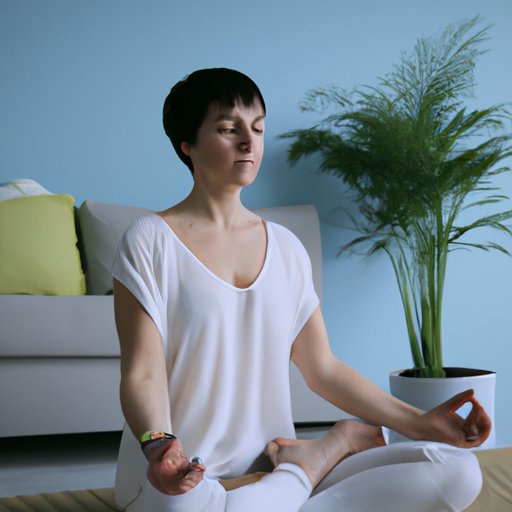Introduction
Meditation is a practice that has been used for centuries to calm the mind and promote well-being. In an increasingly chaotic world, meditation can help individuals find a sense of inner peace and clarity. In this article, we’ll explore how to meditate properly and provide actionable steps for anyone interested in starting or improving their meditation practice.
Understanding the Importance of Posture When Meditating
Posture is a crucial aspect of any successful meditation practice. Proper alignment ensures that you can breathe comfortably and deeply, preventing discomfort or distraction. When sitting for meditation, it’s essential to have a stable and upright posture. Your spine should be lengthened with your head and neck resting gently on top. Keep your shoulders relaxed and your hands resting comfortably.
One way to achieve good posture is to sit in a chair with your feet resting flat on the ground. Alternatively, you can sit cross-legged on a cushion, blanket, or yoga block. Whichever you choose, make sure you’re comfortable and your posture is stable throughout your practice.
Focusing on Your Breath to Clear Your Mind
The foundation of any meditation practice is the breath. Focusing on your breath helps to calm the mind and stay present in the moment. When you first start meditating, it can be challenging to keep your mind from wandering. But as you focus on your breath, you’ll become better at recognizing when your mind has wandered and bringing your attention back to your breath.
One technique for using your breath to calm your mind is to focus on your inhalations and exhalations. As you breathe in, repeat the word “in” to yourself, and as you exhale, repeat the word “out.” This technique helps to anchor your attention on your breath and away from racing thoughts.
It’s common for thoughts and mental distractions to arise during meditation. Instead of fighting these mental distractions, gently acknowledge them and then let them go. Recognizing that mental distractions are normal and learning to let them pass can help you stay present and calm.

Creating a Peaceful Environment Before You Begin
The environment in which you meditate can have a significant impact on the quality of your practice. Creating a calming environment can help set the tone for your meditation and reduce distractions. Reduce noise and other distractions by playing soft instrumental music. Using candles or dimming the lights can also create a peaceful ambiance, as can incorporating scents, such as lavender or peppermint.
Even if you can’t entirely eliminate distractions, such as loud noises or interruptions in a busy household, try creating a specific space exclusively for meditation. This designated space will signal to your brain that it’s time to focus inward and tune out any outside distractions.
Choosing the Right Time of Day to Meditate
The time of day you choose to meditate can also impact your ability to focus and stay present. Some people prefer to meditate early in the morning to start their day feeling grounded and centered. Others may meditate during their lunch break or in the evening to unwind after a long day. Find what works best for you and your daily schedule.
If you’re new to meditation, consider starting with shorter sessions, such as 10 to 15 minutes, at a time, during any time of day you feel the most comfortable with. Then slowly build up to longer sessions and, if necessary, consider experimenting with different times to determine which works best for you.
Experimenting With Different Types of Meditation to Find What Works for You
There is a wide variety of meditation techniques to choose from, including mindfulness meditation, guided meditation, and yoga. Determine which type of meditation resonates most with you based on your personal preferences. Experiment with different forms of meditation to see what works best for your needs.
If you’re feeling stuck or bored with your existing meditation practice, try switching up the type or length of your practice. Trying new things can help keep you engaged, inspired, and energized about your practice.
Accepting That Distraction Is Normal and How to Handle It
Distraction is an inevitable part of any meditation practice. It’s normal to feel that your mind is wandering or racing. Try not to become caught up in these distractions; instead of gently guiding your focus back to your breath or your point of focus.
If you’re feeling particularly distracted, consider incorporating a simple self-compassion mantra, such as “May I be at peace” or “May I be kind to myself.” This technique can help calm and focus your mind while providing emotional support.
Setting Realistic Expectations and Making Meditation a Regular Habit
Like any practice, meditation requires discipline and commitment. Setting realistic expectations for your practice can help you maintain progress and achieve success over time. Don’t expect drastic changes after one session, but rather the small benefits that you notice. Begin with short and consistent sessions and slowly increase the time you meditate.
Committing to a regular meditation routine can help you establish and maintain a consistent practice over time. Set aside a specific time each day for meditation and hold yourself accountable to that practice.
Conclusion
Meditation is a powerful tool to help improve your mental, emotional, and physical health. While there are many ways to meditate, focusing on your breath, maintaining good posture, and creating a calm environment can help you get the most out of your practice. Be patient, gentle, and compassionate with yourself during your meditation journey. With time and practice, you’ll find that your ability to meditate and stay present in the moment will continue to grow.
For support and resources to help you deepen your meditation practice, consider seeking out local or online communities, books, and apps. Remember that like with any habit, consistency is key, so encourage yourself to keep the commitment to this self-care practice – even if it feels uncomfortable at times. With practice, over time, you’ll find that you’re better able to remain present and centered both on and off the meditation cushion.
